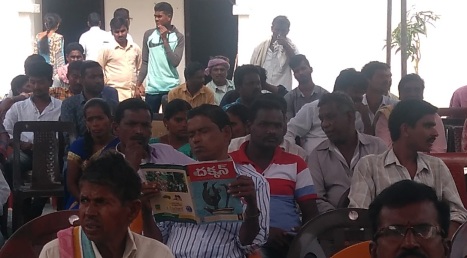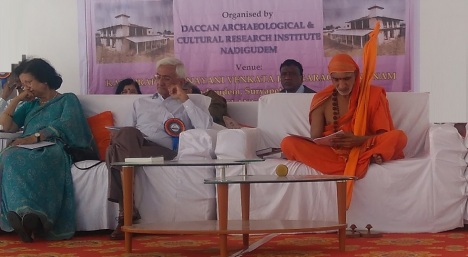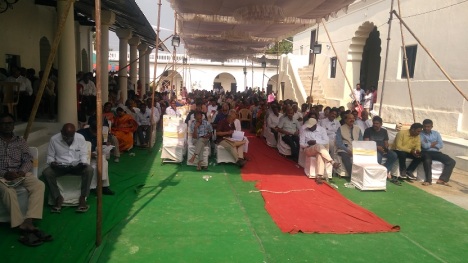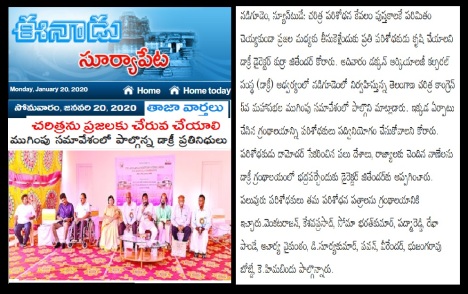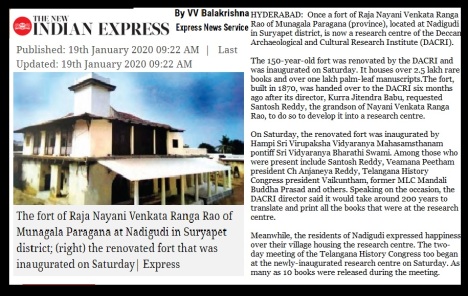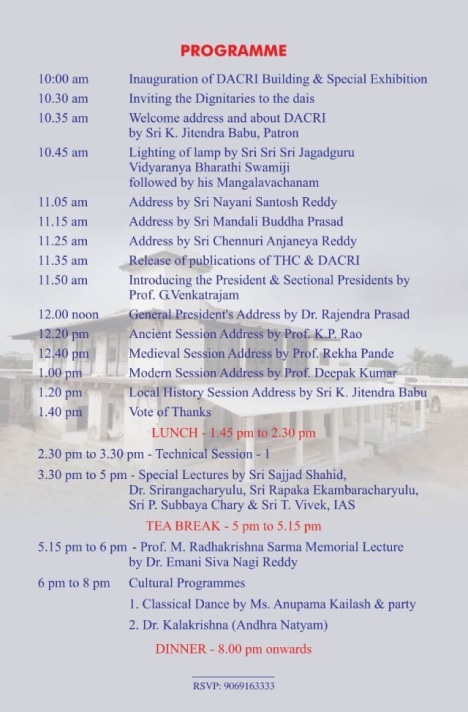The Fifth Telangana History Congress held at Nadigudem, Suryapet, Telangana on January 19th and 20th 2020 concluded! [4]

When I presented my paper, Prof T. Manohar, HOD, History Depot, Kakatiya University, Warangal, was chairing the session

I started with the dolmen found at Nadigudem in Nalgonda District, as discovered and reported by M.L.K. Murthy,

Neolithic axes found at Nadigudem in Nalgonda District, as discovered and reported by M.L.K. Murthy,
Stone Art and Architecture: Manufacture of stone temples, houses, utensils, jars, tubs and others: The technology behind and the tools used: I presented my paper on this topic. I started with archaeological evidence found at Nadigudem and proceeded to cover other aspects. Nadigudem has been situated in a hilly area with Paleolithic cultural evidences. M.L.K. Murthy[1] has pointed out the presence of prehistoric men with the discovery of dolmen and Paleolithic axes at Nadigudem, Nalgonda district. The megalithic sites, burials and related details of the Telangana state have been tabulated in the Appendix-II. As Telangana has been naturally formed hilly area with mineral deposits, men had been exploiting stone and stone implements made thereof. It is not that usage of stone utensils, implements and gadgets that could be considered as megalithic, Neolithic or any lithic culture, but, even in modern culture, it is used for durable and preservative nature. About the availability of ironworking in Telangana, reports have already been published[2]. Therefore, naturally, Telangana people must have worked with stones to manufacture marvellous specimens with high tensile Ferroalloy tools. Thus, stone Art and Architecture, manufacture of stone temples, houses, utensils, jars, tubs and others, the science and technology behind and the tools used, are studied in this paper with the available evidences of Telangana, Andhra and neighbouring states of Tamilnadu, and Karnataka. Telangana archaeologists have discovered many megalithic, neolithic sites [Pullur banda, Gondimalla, Peddamarur etc] with specimens that prove the stone working capabilities of men going back to c.2000 BCE[3]. After giving many examples, I concluded as follows.

I showed many examples stone utensils etc., to prove how the stone was worked with tools according to the requirements of men’s usage.

A huge capstone was used to cover a menhir-type prehistoric burial site in Neremetta. The crane from Hyderabad took four hours to lift the 40 ton capstone
The preference, uniqueness and usage of stone for all purposes (In lieu of conclusion): From the above discussion, the points are summarized as conclusion:
- The Indian selection of stone for many purposes in the art and architecture has been unique. Researchers note that not only the historians, archaeologists and art experts differ in dating IVC, IVC artefacts, Vedic civilization and literature, but also in dating available stone art specimens of all forms.
- Stone has been formed with the creation of earth as a part of Panchabhutas. As a human body with life has been made of Panchabhutas, the stone has been unique, pure and lasts forever. Thus, anything made of stone, preserved in stone, lived with stone would have a long life without degradation.
- Sila was considered divine and ‘Salagrama’ is treated and worshipped as ‘stone-god,’ nature carved Idol of God manifested.
- Thus, the Vedic people referred to live in forests and hilly areas, so that they could get all their requirements.
- The Jains and the Buddhists differed, thus, they located their paces at remote places at the hilly places and viharas. They had to come to villages and cities for their requirements.
- Thus, stone art developed and progressed in one way or the other, giving employment to thousands of people.
- During their periods, the quarrying and deforestation were undertaken in a balanced way, so that there were no ecological imbalances. As the population increased, cities multiplied, imbalances had crept into.
- Modern methods of exploitations, including quarrying and infrastructure development activities, make many monuments disturbed, displaced and disappeared.
- The uniqueness of /Indian stone art expertise, skill in the carving, particularly rock-art architecture and other features has bee unparalleled. Whether the material evidences came first and the architectural manuals composed later or vice versa, both had been in existence definitely 2000 to 5000 YBP depending upon various experts, different theories and varied chronologies.
- In any case, the Indians have been so fascinated with stones and rocks of all forms, used and benefited by their use, and lived with them, that they have not disturbed the ecological imbalances, as modern men do.

I showed many examples stone utensils etc., to prove how the stone was worked with tools according to the requirements of men’s usage.

Bell made of stone hanging in a stone chain – the technology and the tools used behind the manufacture should be considered, appreciated and understood

Stone trough, tub, tank could be found in many places. They were used for storing water, food etc., catering to the need of the travellers etc.

This tub with inlet, outlet etc., is found in the Big Temple, Tanjore, reportedly used by Rajaraja Chola.

This tub with inlet, outlet etc., is found in the Big Temple, Tanjore, reportedly used by Rajaraja Chola. Again the point is the ferroalloy tools used to cut, shape, polish and bring out such item made of stone.

A 15th century stone trough spotted on the right bank of the river Krishna at Tangeda village in Dachepalli mandal of Guntur district. The trough chiselled out in Palnadu lime stone measuring 15ft x 3ft x 3ft with a depth of one foot from the River Krishna to facilitate drinking water for elephants during 15th century
Christian Missionaries: John David resented a paper on the role of Christian missionaries for promoting education, health etc. His way of presentation and the concepts of the [paper show that it was of nature of propaganda. He was quoting biblical verses exhaustively to prove that Jesus Christ was a good healer and so on. Of course, Rekha Pande questioned him, after the presentation.

Importance of Nelakondapalli Buddhist site from Khammam district in Telangana state[4]: G.Chandra Reddy presented this paper. He gave the findings of Maga-stupa, Viharas, Votive stupa, throne, Buddha figures and concluded that Nelakondapalli Buddhist site could be developed into a Buddhist hub to attract international tourists. Therefore, the Telangana government should take steps for tourism development.

Return to Chennai: The paper-reading session was over and the General Secretary opined that paper presenter should be available to listen to other paper presenters also. One should not just read paper and go away. Such trend should not be encouraged. But, the day before, they themselves announced that those who wanted to go immediately, they could read their papers, as pointed out above. After lunch, I decided to proceed to Suryapet, as /I had to vacate the room and proceed to Khammam to catch my train to Chennai. So I came out of the venue and stood on the road near the entrance to request any car that might go to the main road / NH. After some time, I saw one car coming out and I requested them, the person inside was kind enough to agree to drop me on the NH. Thus, I reached the main road at Barkataguda. Then, I got a share-cab to reach Suryapet junction by 3.30pm. I went to the hotel to know that my room-mate and other friends had already checked out and gone. Therefore, I took rest, packed up my luggage and checked out by 4.45 pm. I proceeded to the main road, where I could get a bus to Khammam. By 7.00 pm, I reached khammam BS and then RS by 7.30 pm. As my train G. T. Express would come by 9.00 pm, I was sitting there watching the passengers and trains going to and fro. The train came by one hour late i,e, 10.00 pm. I got into the train to settle down. After few stations, I had the same problem of many passengers just getting inside and filling up space. Of course, this time, there was an objection from co-passengers also, therefore, we could control them. Definitely, I had the most tedious, wearisome and difficult journey to attend one conference with inherent and other difficulties, as explained and pointed out above, in my life time. As the organizers have been well experienced, highly knowledgeable and veterans in the field, they should see that their logistics would satisfy the minimum requirements of the delegates coming to attend the seminar / conference. It is not that satisfying 10 and ignoring 90 out of 100, as all pay the delegates fees. Therefore, they may have a feeling, why should spend thousands of rupees to undergo such treatment. Therefore, if these basics are not taken care of, days are near for the history congress to wind up their activities.

How to strengthen History Congresses?: Having attended more than 700 national and international conferences, seminars, workshops, and other academic meetings, gatherings etc., presented 700 papers, published 300 papers, and personally interacted with thousands of students, faculties, historians, archaeologists etc., I would like to submit the following to the organizers, conductors of the history congresses:
- Plan systematically about the delegates reception, transport accommodation, food, kit with list of papers, academic sessions etc., in advance.
- There is no meaning in forming so many committees with all A to Z names, but, with “do not care” towards delegates.
- Take enough money, but, provide reasonable accommodation, food, transport etc.
- With experience, I can tell with delegate fees, sponsorship, donation etc., the organizers get enough money and therefore, there is no problem in proving such facilities.
- Satisfying coterie type people and harassing others is not the way of conduct of any congress, seminar or conference.
- By sharing, cooking for 100s / 1000s, a lot of money can be saved, therefore, they should provide to the delegates back.
- If they cannot or not able to do so, do not conduct, keep quite.
- By getting delegates or crowd only, you can conduct and therefore, the organizers cannot ignore or harass delegates.
- The delegates incur thousands of rupees by coming from distant places. The serious delegates would definitely feel and understand the mishandling of the proceedings.
- Therefore, plan, take care of the delegates and conduct, otherwise forget the tamasha, jathra or get-together like gatherings.
© K. V. Ramakrishna Rao
21-01-2020


[1] Murty, M. L. K., ed. Pre-and Protohistoric Andhra Pradesh up to 500 bc. Vol. 1. Orient Blackswan, 2003, p.89, 104.
[2] Juleff, G., Sharada Srinivasan, and S. Ranganathan. Pioneering Metallurgy: The origins of iron and steel making in the Southern Indian subcontinent Telangana Field Survey Interim Report 2011, National Institute of Advanced Studies, 2011.
[3] K.P. Rao, Iron Age Culture in South India: Telangana and Andhra Pradesh in Akinori Uesugi (ed.), Iron Age in South Asia, Archaeological Research Institute, Kansai University, 2018, pp.129-144.
[4] His paper – summary – has been printed in the Souvenir of the Telangana History Congress, the Annual Conference 2020, p.34.
Filed under: andhra, anti-vedic, archaeology, Barkatagudem, civilization, DACRI, Deccan Archaeological and Cultural Research Institute, digitization, dilapidated condition, endowment lecture, gadi, Hampi, Hampi mutt, historiography, history, Jitendra, Jitendra Babu, K. V. Ramakrishna Rao, manuscript, manuscriptologist, megalith, megalithic, Nayani venkata Ranga Rao, palm leaf manuscript, paper manuscript, reddy, telangana, Telangana History Congress, telengana, telugu, tensile steel, tourism | Tagged: DACRI, Deccan Archaeological and Cultural Research Institute, divided history, godad, Hampi, Hampi mutt, historian, historicity, historiography, history, indian history, jitedra, Jitendra Babu, K. V. Ramakrishna Rao, Munagala, Munagala gadi, Nadigudem, Nadigudem gadi, Nayani venkata Ranga Rao, Suryapeta, telangana, Telangana History Congress, Vidyaranya Bharathi | 4 Comments »










